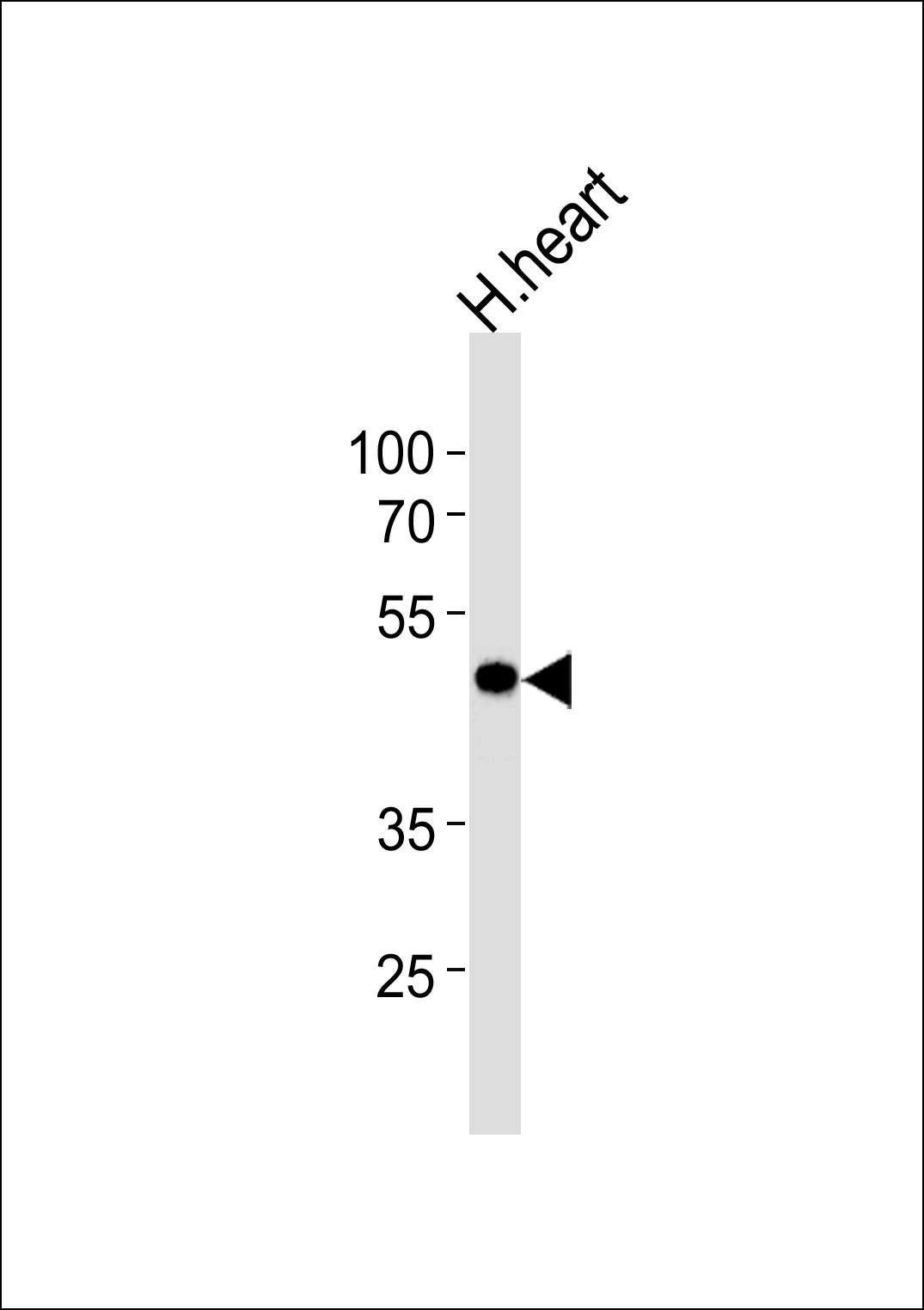KCNAB1 Antibody(N-term)
Affinity Purified Rabbit Polyclonal Antibody (Pab)
- SPECIFICATION
- CITATIONS
- PROTOCOLS
- BACKGROUND

Application
| WB, E |
|---|---|
| Primary Accession | Q14722 |
| Other Accession | NP_003462.2 |
| Reactivity | Human |
| Host | Rabbit |
| Clonality | Polyclonal |
| Isotype | Rabbit IgG |
| Calculated MW | 46563 Da |
| Antigen Region | 15-44 aa |
| Gene ID | 7881 |
|---|---|
| Other Names | Voltage-gated potassium channel subunit beta-1, K(+) channel subunit beta-1, Kv-beta-1, KCNAB1, KCNA1B |
| Target/Specificity | This KCNAB1 antibody is generated from rabbits immunized with a KLH conjugated synthetic peptide between 15-44 amino acids from the N-terminal region of human KCNAB1. |
| Dilution | WB~~1:1000 E~~Use at an assay dependent concentration. |
| Format | Purified polyclonal antibody supplied in PBS with 0.09% (W/V) sodium azide. This antibody is purified through a protein A column, followed by peptide affinity purification. |
| Storage | Maintain refrigerated at 2-8°C for up to 2 weeks. For long term storage store at -20°C in small aliquots to prevent freeze-thaw cycles. |
| Precautions | KCNAB1 Antibody(N-term) is for research use only and not for use in diagnostic or therapeutic procedures. |
| Name | KCNAB1 (HGNC:6228) |
|---|---|
| Synonyms | KCNA1B |
| Function | Regulatory subunit of the voltage-gated potassium (Kv) Shaker channels composed of pore-forming and potassium-conducting alpha subunits and of regulatory beta subunits (PubMed:17156368, PubMed:17540341, PubMed:19713757, PubMed:7499366, PubMed:7603988). The beta-1/KCNAB1 cytoplasmic subunit mediates closure of delayed rectifier potassium channels by physically obstructing the pore via its N- terminal domain and increases the speed of channel closure for other family members (PubMed:9763623). Promotes the inactivation of Kv1.1/KCNA1, Kv1.2/KCNA2, Kv1.4/KCNA4, Kv1.5/KCNA5 and Kv1.6/KCNA6 alpha subunit-containing channels (PubMed:12077175, PubMed:12130714, PubMed:15361858, PubMed:17156368, PubMed:17540341, PubMed:19713757, PubMed:7499366, PubMed:7603988, PubMed:7649300, PubMed:7890764, PubMed:9763623). Displays nicotinamide adenine dinucleotide phosphate (NADPH)-dependent aldoketoreductase activity by catalyzing the NADPH- dependent reduction of a variety of endogenous aldehydes and ketones (By similarity). The binding of NADPH is required for efficient down- regulation of potassium channel activity (PubMed:17540341). Oxidation of the bound NADPH restrains N-terminal domain from blocking the channel, thereby decreasing N-type inactivation of potassium channel activity (By similarity). |
| Cellular Location | Cytoplasm. Membrane {ECO:0000250|UniProtKB:P63144}; Peripheral membrane protein; Cytoplasmic side. Cell membrane; Peripheral membrane protein; Cytoplasmic side. Note=Recruited to the cytoplasmic side of the cell membrane via its interaction with pore-forming potassium channel alpha subunits. |
| Tissue Location | In brain, expression is most prominent in caudate nucleus, hippocampus and thalamus. Significant expression also detected in amygdala and subthalamic nucleus. Also expressed in both healthy and cardiomyopathic heart. Up to four times more abundant in left ventricle than left atrium. |

Thousands of laboratories across the world have published research that depended on the performance of antibodies from Abcepta to advance their research. Check out links to articles that cite our products in major peer-reviewed journals, organized by research category.
info@abcepta.com, and receive a free "I Love Antibodies" mug.
Provided below are standard protocols that you may find useful for product applications.
Background
Potassium channels represent the most complex class of voltage-gated ion channels from both functional and structural standpoints. Their diverse functions include regulating neurotransmitter release, heart rate, insulin secretion, neuronal excitability, epithelial electrolyte transport, smooth muscle contraction, and cell volume. Four sequence-related potassium channel genes - shaker, shaw, shab, and shal - have been identified in Drosophila, and each has been shown to have human homolog(s). This gene encodes a member of the potassium channel, voltage-gated, shaker-related subfamily. This member includes three distinct isoforms which are encoded by three alternatively spliced transcript variants of this gene. These three isoforms are beta subunits, which form heteromultimeric complex with alpha subunits and modulate the activity of the pore-forming alpha subunits.
References
Rose, J.E., et al. Mol. Med. 16 (7-8), 247-253 (2010) :
Decher, N., et al. EMBO J. 27(23):3164-3174(2008)
Cavalleri, G.L., et al. Lancet Neurol 6(11):970-980(2007)
Lamesch, P., et al. Genomics 89(3):307-315(2007)
Lunetta, K.L., et al. BMC Med. Genet. 8 SUPPL 1, S13 (2007) :
If you have used an Abcepta product and would like to share how it has performed, please click on the "Submit Review" button and provide the requested information. Our staff will examine and post your review and contact you if needed.
If you have any additional inquiries please email technical services at tech@abcepta.com.













 Foundational characteristics of cancer include proliferation, angiogenesis, migration, evasion of apoptosis, and cellular immortality. Find key markers for these cellular processes and antibodies to detect them.
Foundational characteristics of cancer include proliferation, angiogenesis, migration, evasion of apoptosis, and cellular immortality. Find key markers for these cellular processes and antibodies to detect them. The SUMOplot™ Analysis Program predicts and scores sumoylation sites in your protein. SUMOylation is a post-translational modification involved in various cellular processes, such as nuclear-cytosolic transport, transcriptional regulation, apoptosis, protein stability, response to stress, and progression through the cell cycle.
The SUMOplot™ Analysis Program predicts and scores sumoylation sites in your protein. SUMOylation is a post-translational modification involved in various cellular processes, such as nuclear-cytosolic transport, transcriptional regulation, apoptosis, protein stability, response to stress, and progression through the cell cycle. The Autophagy Receptor Motif Plotter predicts and scores autophagy receptor binding sites in your protein. Identifying proteins connected to this pathway is critical to understanding the role of autophagy in physiological as well as pathological processes such as development, differentiation, neurodegenerative diseases, stress, infection, and cancer.
The Autophagy Receptor Motif Plotter predicts and scores autophagy receptor binding sites in your protein. Identifying proteins connected to this pathway is critical to understanding the role of autophagy in physiological as well as pathological processes such as development, differentiation, neurodegenerative diseases, stress, infection, and cancer.


